I’ve stood there in steel-toe boots, staring at a machine we couldn’t move, because we brought the wrong trailer. The crew was ready, the operator was on standby, and nothing moved for hours.
That day stuck with me. It wasn’t just frustrating, it was avoidable.
After years in the field and countless hauls, I’ve learned that matching the trailer to the equipment is just as important as the equipment itself. This guide comes straight from hands-on experience, no fluff, just what works out there on real jobs.
In the next few minutes, you’ll get a clear, no-nonsense breakdown of 8 essential equipment trailer types. We’ll cover what each one is good for, when to use it, and how it can save you time and headaches on site.
Let’s get started!
Quick Comparison Chart
Choosing the right equipment trailer can directly impact your team’s efficiency, safety, and bottom line. Below is a quick comparison of the most common trailer types based on key factors businesses care about:
| Trailer Type | Best For | Load Capacity | Ease of Loading | Weather Protection | Maneuverability | Use Case Flexibility |
| Flatbed | Wide, heavy, or irregular loads | High | Moderate | None | Moderate | Very High |
| Lowboy | Oversized or tall heavy equipment | Very High | Easy (with ramps) | None | Low | Specialized |
| Gooseneck | Mid-to-heavy loads with tight turns | High | Moderate | None | High | High |
| Tilt Deck | Wheeled/tracked low-clearance machines | Moderate to High | Very Easy | None | Moderate | High |
| Dump | Loose material, debris, gravel | Moderate | Very Easy | None | Moderate | Medium |
| Enclosed | Tools, electronics, secure equipment | Moderate | Moderate | Full | Low | Medium |
| Deckover | Wide materials, pallets, bulky gear | High | Moderate | None | Moderate | High |
| Dovetail | Low-clearance wheeled equipment | Moderate | Very Easy | None | Moderate | Specialized |
This table should help you quickly match the right trailer for the right job. Every trailer has strengths. Your job is to pick the one that works smarter for your operation.
1. Flatbed Trailers
Flatbed trailers are the workhorses of the equipment transport world. With an open platform, no sides, no roof, they’re built for maximum loading freedom. If it fits and you can strap it down, you can haul it.
I remember one job early in my career. We had to move 4 oversized HVAC units to a rooftop project across the state. There wasn’t a trailer on-site that could legally or safely handle the load, until a flatbed rolled in.
We craned those units straight onto the deck, chained them tightly, and rolled them out before lunch. That job made me respect just how much a flatbed can do when you’re up against tough timelines.
Key Features
- Open Platform: No walls or roof—just a reinforced flat surface.
- Multiple Loading Angles: Load from the sides, rear, or even overhead by crane.
- Standard Lengths: Typically range from 48 to 53 feet.
- Heavy-Duty Build: Made with high-tensile steel or aluminum for serious loads.
- Forklift & Crane Friendly: Compatible with most job site loading methods.
Ideal Use Cases
Flatbeds are ideal when you’re hauling freight that doesn’t need weather protection—construction materials, machinery, palletized cargo, steel, or anything oversized.
If you’re in construction, energy, manufacturing, or logistics—this trailer is probably already a staple in your operation. If not, it should be.
Pros and Cons
Pros:
- Versatile: Hauls wide, tall, or odd-shaped loads with ease.
- Quick Loading/Unloading: Save time with flexible access points.
- Cost-Effective: Fewer moving parts mean lower maintenance costs.
- Readily Available: Common, proven, and easy to deploy at scale.
Cons:
- No Weather Protection: Rain, wind, and sun exposure can damage unprotected cargo.
- Requires Skilled Load Securement: Safety depends on proper tie-downs and weight distribution.

2. Lowboy Trailers
Lowboy trailers sit lower to the ground than almost any other hauler, making them perfect for tall or heavy equipment. I’ve used them to move 20-ton excavators across state lines without sweating bridge clearances. When height and weight are an issue, lowboys are the trailer you trust.
Key Features
- Low Deck Height: Sits as low as 18 inches off the ground for taller loads.
- Dual Drops: One drop after the gooseneck and one before the wheels.
- High Weight Capacity: Can handle up to 80,000 lbs with the right permits.
- Hydraulic Ramps or Removable Gooseneck (RGN): Easy equipment loading.
- Stable Center of Gravity: Reduces swaying and improves safety on the road.
Ideal Use Cases
Use a lowboy when your equipment is too tall or heavy for a standard flatbed. Think bulldozers, cranes, large excavators, or industrial tanks.
If your business moves oversized machinery or deals with DOT height restrictions—this is your go-to trailer. I’ve worked with clients in heavy construction and energy who won’t move anything big without a lowboy in the lineup.
Pros and Cons
Pros:
- Handles Oversized Loads: No stress over height or legal limits.
- Extreme Stability: Ideal for heavy, high-value cargo.
- Easier to Load Heavy Equipment: Thanks to the low deck and ramps.
- Better Road Clearance: Reduces risk of bridge or overpass collisions.
Cons:
- Special Permits Often Required: Especially for loads over legal dimensions.
- Heavier Trailer Weight: Can reduce your payload capacity.
- Not as Versatile as Flatbeds: Purpose-built for specific load types.
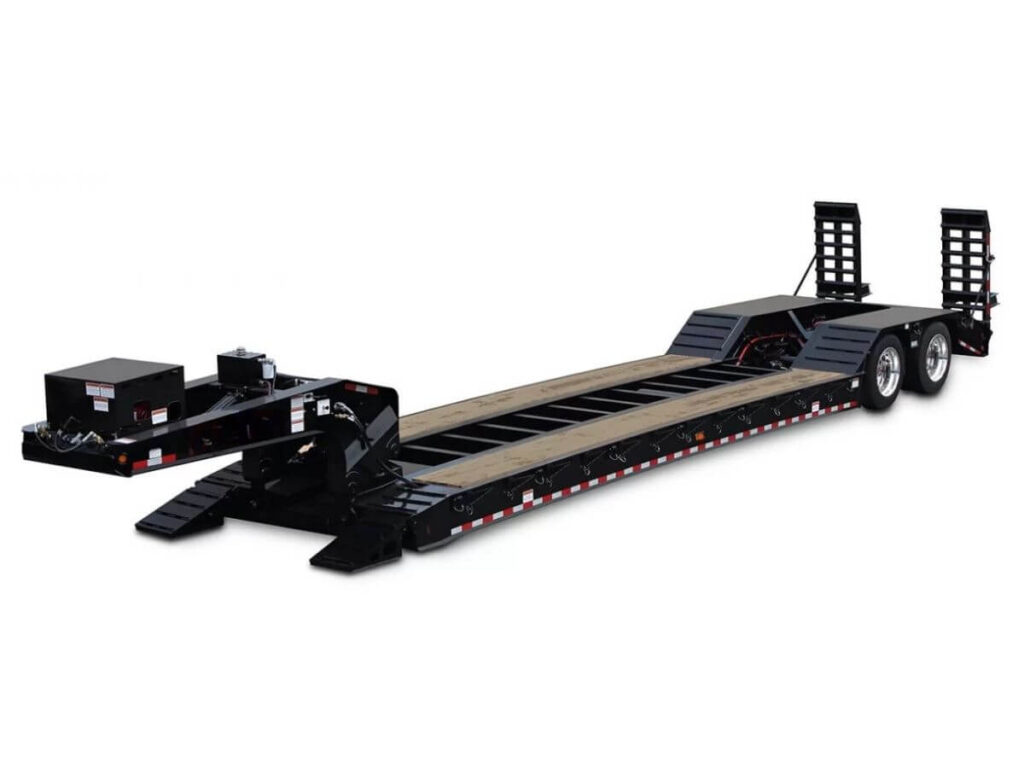
3. Gooseneck Trailers
Gooseneck trailers connect over the bed of your truck, giving you better stability and weight distribution than a bumper-pull ever could.
I remember hauling a load of compact track loaders through a mountain pass—tight turns, steep grades.
A bumper-pull would’ve been a white-knuckle mess. But with a gooseneck? Rock solid.
Key Features
- Hitch Design: Attaches to a ball in the bed of the truck, not the bumper.
- Improved Weight Distribution: Keeps your load balanced and under control.
- Tighter Turning Radius: Easier navigation in tight spaces or job sites.
- Heavier Towing Capacity: Built to handle bulkier and heavier loads.
- Optional Deckover or Drop Deck Styles: Flexible to suit different equipment types.
Ideal Use Cases
Perfect for contractors, equipment haulers, and fleet operators moving mid-sized machinery, materials, or vehicles.
If your team hauls loads regularly through job sites, urban zones, or narrow access roads—you’ll appreciate the tighter control and smoother ride of a gooseneck. They’re especially valuable in agricultural, construction, and utility sectors.
Pros and Cons
Pros:
- Superior Stability: Less sway and bounce at highway speeds.
- Higher Payload Capacity: Compared to bumper-pull trailers.
- Better Maneuverability: Especially in tight or uneven terrain.
- Professional-Grade Build: Trusted by serious operators for serious work.
Cons:
- Requires Pickup with Gooseneck Hitch: Not all trucks are prepped for it.
- Heavier Than Standard Trailers: Slightly more wear on the tow vehicle.
- Takes Some Getting Used To: Backing up is a learning curve at first.
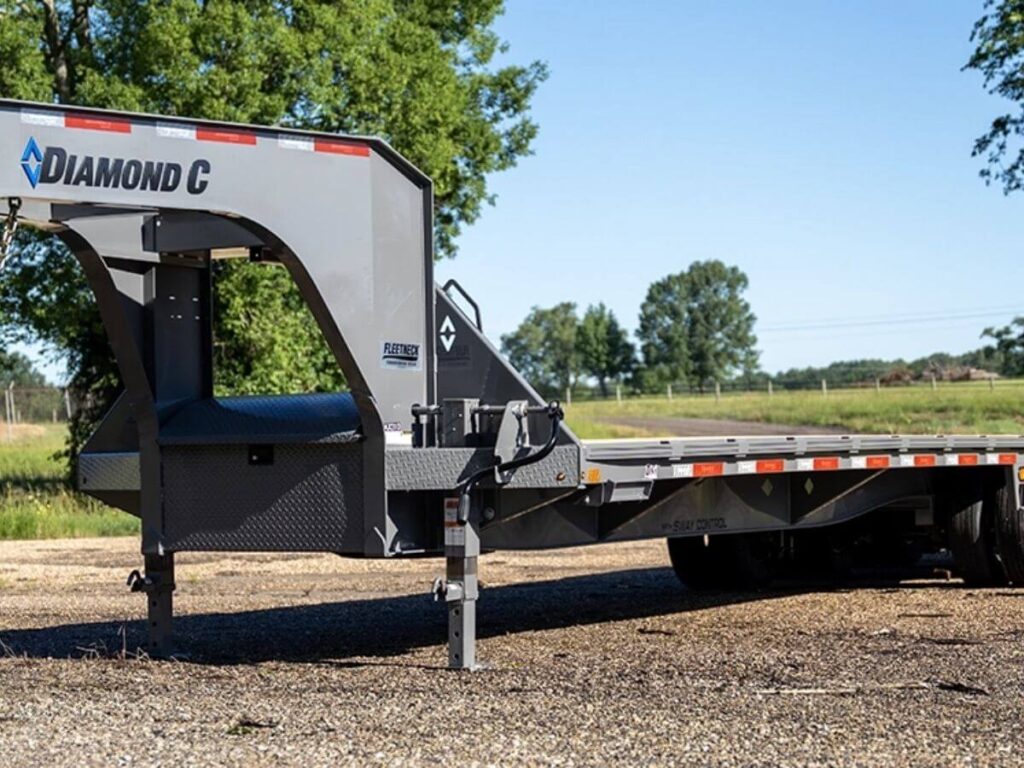
4. Tilt Deck Trailers
Tilt deck trailers are built for simplicity. The deck tilts down, so your equipment can be driven or rolled on—no ramps, no hassle. I’ll never forget loading a skid steer in the rain.
Steel ramps were slick, dangerous. Swapped in a tilt deck the next day, and we never looked back.
Key Features
- Hydraulic or Gravity Tilt: Smooth tilt mechanism makes loading fast.
- No Need for Ramps: Safer, especially in poor weather or on uneven ground.
- Low Loading Angle: Easier for low-clearance equipment.
- Available in Full or Partial Tilt Designs: Some models tilt only a portion of the deck.
- Heavy-Duty Construction: Built to handle machines, vehicles, and dense loads.
Ideal Use Cases
Tilt decks are perfect for crews hauling wheeled or tracked equipment like skid steers, mini excavators, compact tractors, or forklifts, especially in environments where setup time matters.
We’ve seen businesses across construction, landscaping, and municipal fleets benefit from these trailers. At Rhinotrail, we’ve built tilt decks for teams that don’t have time to mess with ramps or second chances. If you want fast, safe, and efficient loading, this is it.
Pros and Cons
Pros:
- Quick, One-Person Operation: Save time and labor on every load.
- Improved Safety: No ramps means fewer injury risks and no alignment issues.
- Great for Low-Clearance Equipment: Smooth loading without scraping or dragging.
- Durable Build: Handles repeated use in tough field conditions.
Cons:
- More Moving Parts: Hydraulic systems require basic maintenance.
- Higher Initial Cost: Compared to simpler utility trailers.
- Weight Distribution Matters: Poor loading can affect tilt function.
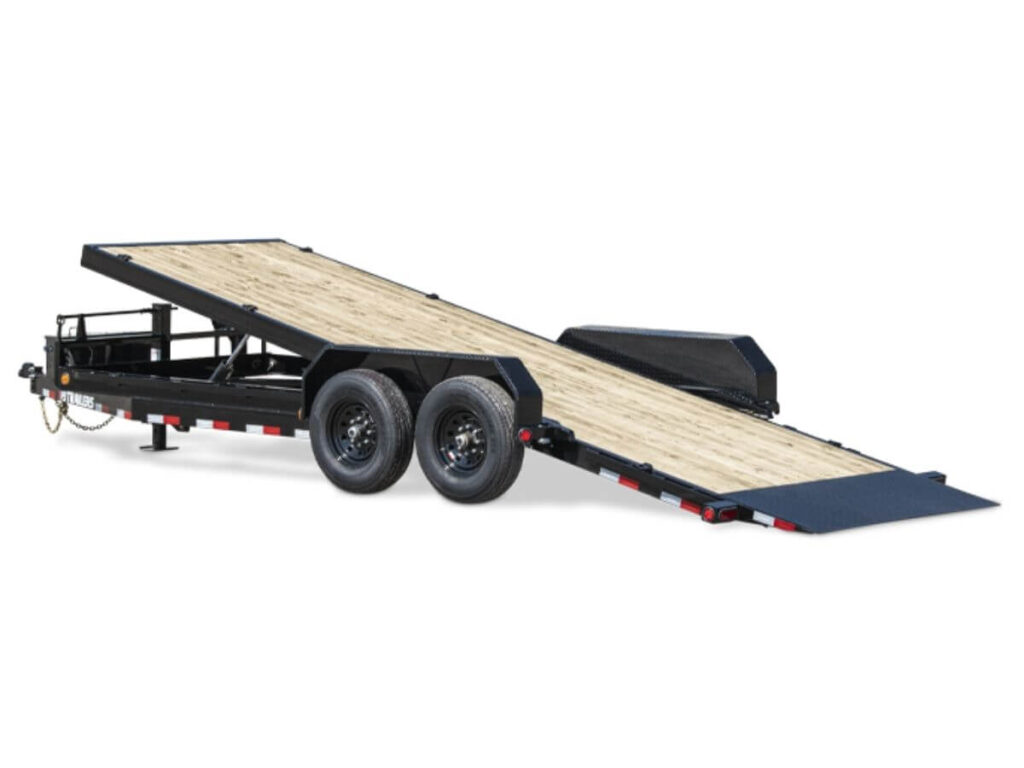
5. Dump Trailers
Dump trailers are designed for fast, controlled unloading of loose materials like gravel, soil, debris, or demolition waste. They use hydraulic lifts to raise the bed and dump the contents, saving you hours of manual labor.
I’ve used them on job sites where time was tight and shovels weren’t an option. One button, one operator, and the load’s on the ground. Simple. Efficient. Built for tough jobs that don’t wait.
Key Features
- Hydraulic Lift System: Raises the bed to unload materials with ease.
- High-Side Walls: Keeps loose or bulky material contained in transit.
- Double or Single Axle Options: Built to match various load sizes.
- Reinforced Steel Bed: Durable for rough use and heavy materials.
- Rear Barn or Spreader Gates: Gives you options on how material exits.
Ideal Use Cases
Dump trailers are essential for businesses in construction, demolition, landscaping, and municipal work. They’re perfect when you need to haul and unload fast, especially with bulk material that doesn’t require precise placement.
At Rhinotrail, we manufacture heavy-duty dump trailers designed to take the beating your workday throws at them. Whether you’re clearing job sites or hauling material in and out of tight zones, our trailers help crews move faster and safer, with less manpower and zero wasted time.
Pros and Cons
Pros:
- Fast Unloading: Cut down labor time dramatically.
- Reduces Injury Risk: No manual unloading or heavy lifting required.
- Built for Tough Loads: Handles everything from dirt to demolition debris.
- Flexible Size Options: Suits both small crews and large-scale operations.
Cons:
- Hydraulics Require Maintenance: Routine checks keep it reliable.
- Higher Center of Gravity When Raised: Must be used on level ground.
- Not Ideal for Oversized Equipment: Primarily designed for loose material.
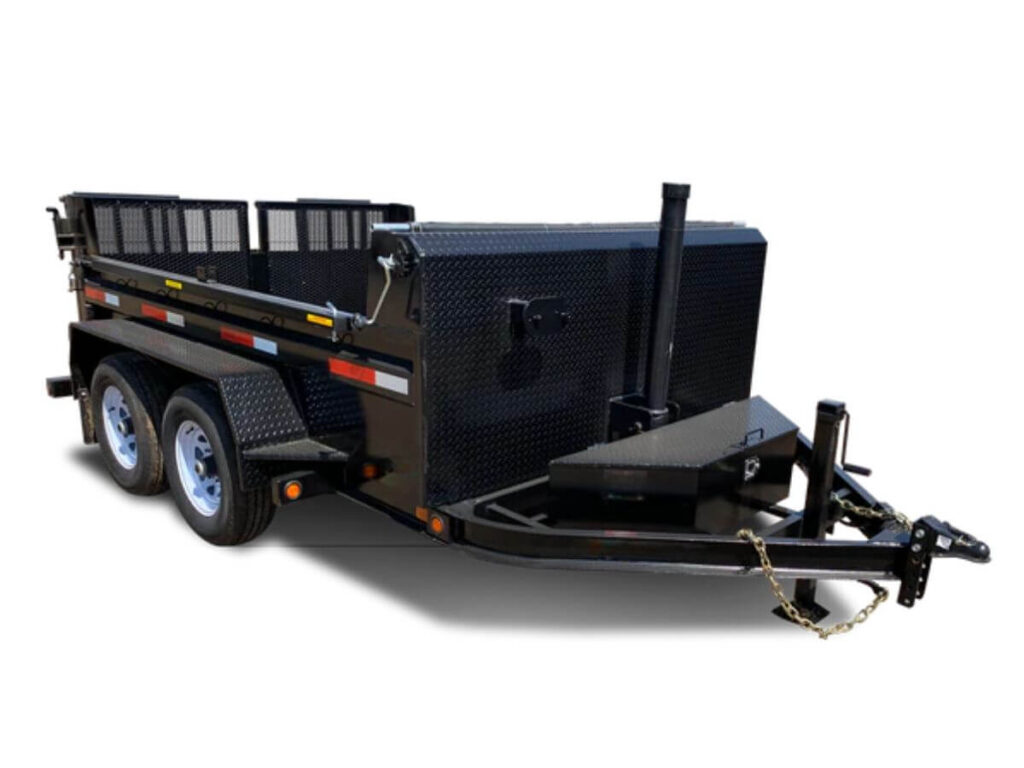
6. Enclosed Trailers
Enclosed trailers are like mobile storage units, fully covered, lockable, and protected from the elements. I once lost a set of sensitive tools to an unexpected downpour.
After that, we switched to enclosed trailers for anything we couldn’t afford to get soaked or stolen. It’s peace of mind on wheels.
Key Features
- Fully Enclosed Design: Protects cargo from weather, dust, and theft.
- Lockable Doors: Keep valuable equipment secure during transport and storage.
- Interior Tie-Downs: Secure loads to prevent shifting in transit.
- Optional Side Doors & Vents: Easier access and better airflow if needed.
- Customizable Interiors: Add shelving, racks, lighting, or workspace areas.
Ideal Use Cases
If your business hauls sensitive equipment, tools, electronics, or gear that simply can’t get wet or go missing, this trailer is a must. They’re commonly used in mobile service industries, utility work, event production, HVAC, and even construction trades where keeping gear safe and dry is non-negotiable.
Whether you’re transporting high-value equipment or need an on-site storage solution that rolls where you go, enclosed trailers give you flexibility without compromise.
Pros and Cons
Pros:
- Weatherproof and Secure: Keep your cargo safe no matter the forecast.
- Mobile Storage: Doubles as a secure unit on job sites.
- Professional Appearance: Clean, enclosed design makes a solid first impression.
- Customizable Interiors: Can be tailored to your crew’s workflow.
Cons:
- Limited Load Size: Internal height and width can restrict larger equipment.
- Heavier Weight: Can reduce fuel efficiency or payload.
- Less Versatile: Not ideal for irregular or oversized cargo.
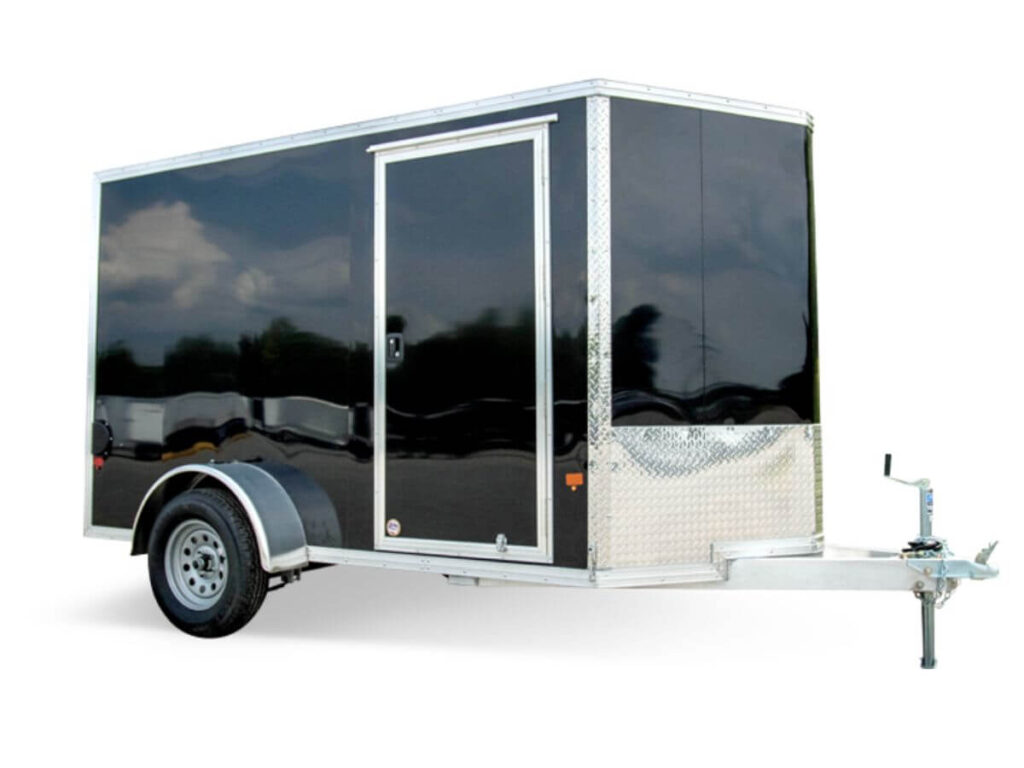
7. Deckover Trailers
Deckover trailers are flatbed-style trailers where the deck sits above the wheels, giving you a full-width platform with zero wheel wells in the way. That extra space makes all the difference when you’re hauling wider loads, like lumber packs, pallets, or oversized equipment.
I remember loading a large generator once with just inches to spare on a standard trailer. It was a nightmare. Switched to a deckover, and suddenly we had breathing room, better balance, and no stress.
Deckover trailers are built for businesses that need space, strength, and simplicity all in one.
Key Features
- Full-Width Deck: Extends over the wheels for maximum usable space.
- Higher Deck Height: Usually sits 34–38 inches off the ground.
- No Wheel Wells: Makes loading wide equipment or materials easier.
- Reinforced Frame: Built for heavy-duty commercial use.
- Ramp Options Available: Rear ramps or slide-out ramps for easier loading.
Ideal Use Cases
Deckover trailers are great for transporting pallets, building materials, portable job site equipment, or anything with an awkward footprint. They’re especially valuable for construction companies, agriculture fleets, and equipment rental businesses that move a variety of cargo.
If you’re tired of fighting around fenders or wasting deck space, a deckover can simplify your workflow—and keep your team moving.
Pros and Cons
Pros:
- Wider Deck Space: Perfect for bulky or odd-shaped loads.
- No Obstructions: Load and unload without wheel wells getting in the way.
- Commercial-Grade Strength: Designed to handle tough, daily use.
- Flexible Loading Options: Works well with forklifts, cranes, or ramps.
Cons:
- Higher Deck Height: Increases loading angle, not ideal for low-clearance gear.
- Less Stable for Tall Loads: Center of gravity is slightly higher than a lowboy or tilt deck.
- Heavier Weight: Can slightly reduce towing efficiency depending on the build.
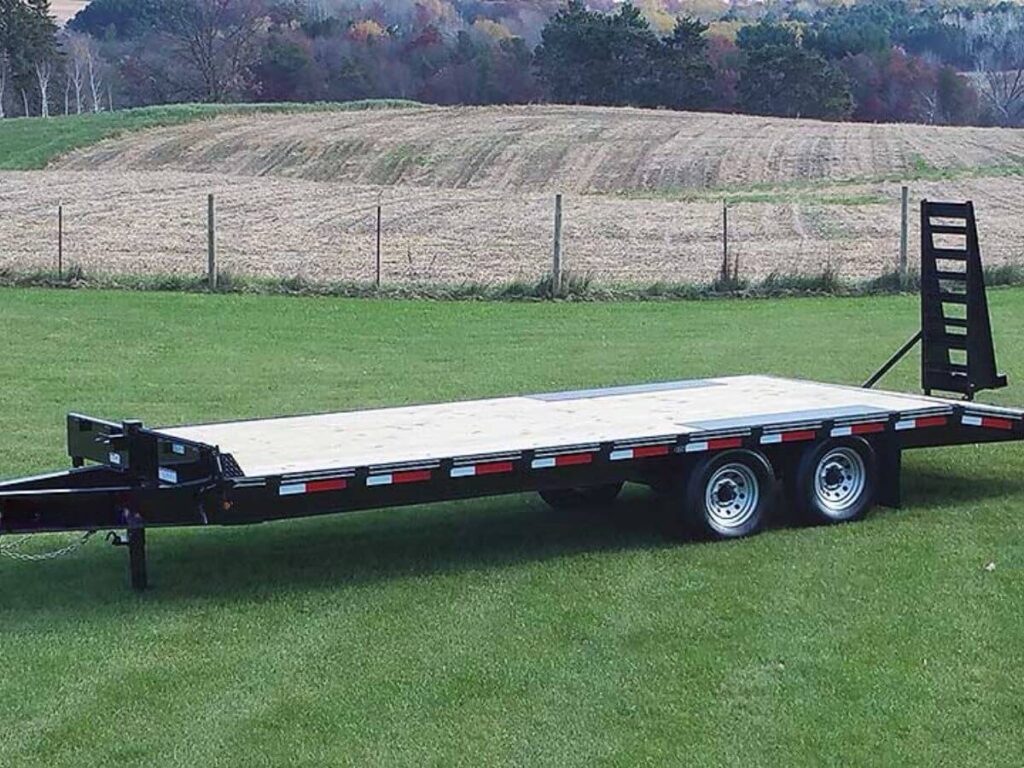
8. Dovetail Trailers
Dovetail trailers are designed with a sloped rear section, called the “dovetail”, that makes loading equipment safer and smoother, especially for machines with low ground clearance. I once had a compact tractor bottom out on a standard trailer ramp, and we spent 45 minutes trying not to wreck the undercarriage.
Swapped to a dovetail setup, and it loaded like a dream.
It’s a small design tweak with a big impact, especially when you’re hauling valuable, sensitive equipment.
Key Features
- Angled Rear Deck: Built-in slope allows for smoother transitions when loading.
- Lower Loading Angle: Reduces stress on equipment and operator.
- Integrated Ramps: Fold-up or slide-in ramps pair with the dovetail for easier access.
- Wide Deck Options: Supports everything from small tractors to mid-sized machinery.
- Steel-Reinforced Construction: Tough enough for commercial-grade use.
Ideal Use Cases
Dovetail trailers are ideal for landscaping businesses, ag operations, and small equipment rental companies moving zero-turn mowers, tractors, ATVs, or compact machinery. They shine when you’re loading low-clearance units or wheeled equipment frequently.
If your crew deals with loading issues on regular trailers or if speed and safety during equipment transfer are key, this is a smarter, more efficient option.
Pros and Cons
Pros:
- Smoother Loading Experience: Lower angle means less scraping, less strain.
- Increased Safety: Reduces the risk of tipping or undercarriage damage.
- Great for Low-Clearance Equipment: Especially mowers, ATVs, and small tractors.
- Fast Operation: Perfect for teams loading in and out all day.
Cons:
- Fixed Angle Takes Up Deck Space: Slightly reduces usable flatbed area.
- Not Ideal for Heavy Equipment: Best suited for lighter to mid-weight loads.
- Requires Level Ground: Slope and ramps perform best on flat surfaces.
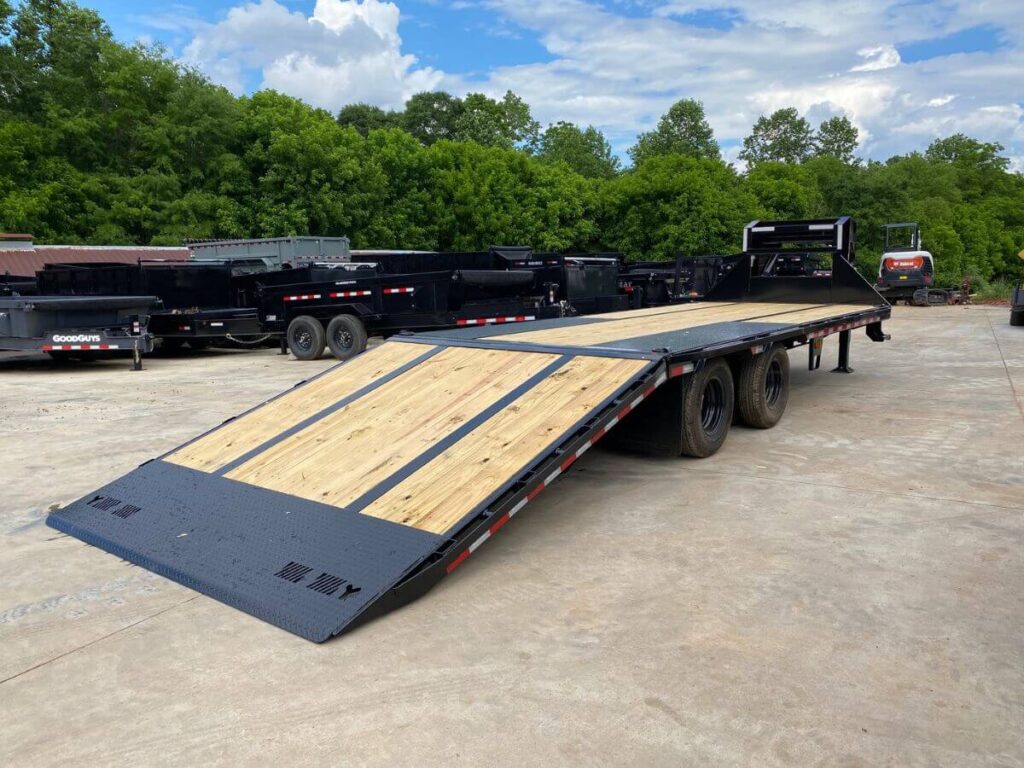
Conclusion
You’ve just walked through 8 types of equipment trailers, and what each one does best.
We broke down the what, when, and how so your team doesn’t waste time or money. You’re not guessing anymore.
I’ve been in your boots. I’ve made the trailer mistakes. That’s why I want you to get this right the first time.
Let’s move your business in the right direction—one trailer at a time.
Which trailer are you still unsure about? Reach out today, and let’s talk through it together.


